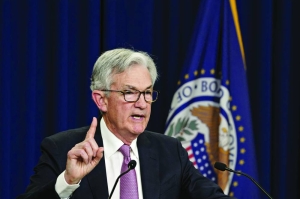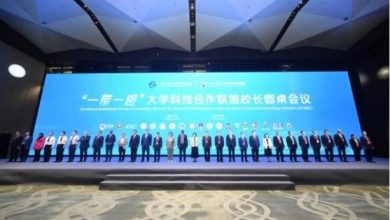Global South
Powell confronts policy crossroads with all eyes on Jackson Hole

[ad_1]

Jerome Powell, chairman of the US Federal Reserve.
Chair Jerome Powell will usher in the next chapter in the Federal Reserve’s inflation battle on Friday, when he’s expected to set the table for an interest-rate cut while reassuring investors that policymakers can stave off a sharp economic slowdown.
The hotly anticipated speech at the Fed’s annual gathering in Jackson Hole, Wyoming, comes at a high stakes moment for the US central bank and the $27tn Treasury market. Powell and his colleagues appear on course to lower borrowing costs just seven weeks before the presidential election, a precarious task that will put the Fed chief and his colleagues under intense public scrutiny. It also comes as officials pay increasing attention to the cooling labour market after years of laser focus on price pressures.
“The question is: Will we have a policy error? That’s why the market’s teetering on edge around the Jackson Hole statement,” said Joseph Brusuelas, chief economist at RSM US LLP. “What we need to hear from the chairman is where the Fed is on the potential policy pivot.”
Investors have been on edge as they try to anticipate the pace and size of the cuts ahead. July’s labour-market figures set off a serious bout of market volatility in early August, when the S&P 500 Index of US stocks lost more than 6% in three trading days. Treasuries rallied and, for several days, traders predicted the Fed would launch rate cuts in September with a larger-than-usual move of 50 basis points.
Powell and fellow policymakers have misstepped before.
They have deftly guided inflation back toward their 2% target, but that came after they failed to move quickly enough to stem rising inflation during the pandemic. Fed officials are now determined to avoid a similar wreck on the employment front just as price pressures cool.
But cracks have appeared in what had been a surprisingly, and historically, strong jobs market.
Last month, US employers slowed their pace of hiring, while the unemployment rate ticked up for the fourth consecutive time, stoking concerns that high interest rates are dragging the labour market closer to a tipping point. Several economists are also expecting the government Wednesday to make a significant downward revision of employment reports in the year through March.
A key question for those watching Powell, particularly in bond markets, is whether another lacklustre jobs report would open the door to a jumbo-sized cut next month, or force the Fed to take an aggressive approach to cutting rates in the months that follow.
“There could be an argument for going a little bit faster upfront and then slowing,” said Matthew Luzzetti, chief US economist at Deutsche Bank. “I think that argument really only gains substantial weight if there is evidence that the labour market is weakening in a more meaningful way.”
When Powell spoke a year ago at Jackson Hole, he and his colleagues still seemed headed in the opposite direction.
Fed officials had, just a month before, lifted their benchmark rate to a range of 5.25-5.5% — the highest level in a generation. Powell described the labour market as tight, called inflation “too high” and said the Fed was “prepared to raise rates further if appropriate.”
Relief has since arrived. While inflation remains above the Fed’s 2% goal, it has come down notably. A key measure of underlying price pressures cooled in July for a fourth straight month, confirming the downward trend.
“We expect him to acknowledge that conditions are in place for them to begin dialling back policy soon,” said Pooja Sriram, an economist at Barclays. “It’s not clear whether he’s going to explicitly say September or not, but I think the message would be that they seem well-positioned to do that.”
Powell’s message this year will require careful calibration. The rationale for cuts will have to be strong enough to address the political pressures surrounding the Fed in this election year. That could involve pointing to a slowing jobs market and softening growth.
The hotly anticipated speech at the Fed’s annual gathering in Jackson Hole, Wyoming, comes at a high stakes moment for the US central bank and the $27tn Treasury market. Powell and his colleagues appear on course to lower borrowing costs just seven weeks before the presidential election, a precarious task that will put the Fed chief and his colleagues under intense public scrutiny. It also comes as officials pay increasing attention to the cooling labour market after years of laser focus on price pressures.
“The question is: Will we have a policy error? That’s why the market’s teetering on edge around the Jackson Hole statement,” said Joseph Brusuelas, chief economist at RSM US LLP. “What we need to hear from the chairman is where the Fed is on the potential policy pivot.”
Investors have been on edge as they try to anticipate the pace and size of the cuts ahead. July’s labour-market figures set off a serious bout of market volatility in early August, when the S&P 500 Index of US stocks lost more than 6% in three trading days. Treasuries rallied and, for several days, traders predicted the Fed would launch rate cuts in September with a larger-than-usual move of 50 basis points.
Powell and fellow policymakers have misstepped before.
They have deftly guided inflation back toward their 2% target, but that came after they failed to move quickly enough to stem rising inflation during the pandemic. Fed officials are now determined to avoid a similar wreck on the employment front just as price pressures cool.
But cracks have appeared in what had been a surprisingly, and historically, strong jobs market.
Last month, US employers slowed their pace of hiring, while the unemployment rate ticked up for the fourth consecutive time, stoking concerns that high interest rates are dragging the labour market closer to a tipping point. Several economists are also expecting the government Wednesday to make a significant downward revision of employment reports in the year through March.
A key question for those watching Powell, particularly in bond markets, is whether another lacklustre jobs report would open the door to a jumbo-sized cut next month, or force the Fed to take an aggressive approach to cutting rates in the months that follow.
“There could be an argument for going a little bit faster upfront and then slowing,” said Matthew Luzzetti, chief US economist at Deutsche Bank. “I think that argument really only gains substantial weight if there is evidence that the labour market is weakening in a more meaningful way.”
When Powell spoke a year ago at Jackson Hole, he and his colleagues still seemed headed in the opposite direction.
Fed officials had, just a month before, lifted their benchmark rate to a range of 5.25-5.5% — the highest level in a generation. Powell described the labour market as tight, called inflation “too high” and said the Fed was “prepared to raise rates further if appropriate.”
Relief has since arrived. While inflation remains above the Fed’s 2% goal, it has come down notably. A key measure of underlying price pressures cooled in July for a fourth straight month, confirming the downward trend.
“We expect him to acknowledge that conditions are in place for them to begin dialling back policy soon,” said Pooja Sriram, an economist at Barclays. “It’s not clear whether he’s going to explicitly say September or not, but I think the message would be that they seem well-positioned to do that.”
Powell’s message this year will require careful calibration. The rationale for cuts will have to be strong enough to address the political pressures surrounding the Fed in this election year. That could involve pointing to a slowing jobs market and softening growth.
[ad_2]
Source link







